First of all, I would like to express my gratitude to the President of JSC "Solikamskbumprom" Mr. Viktor I. Baranov for or-ganizing the branch scientific and practical conference "In harmony with nature" - "Environmental protection in the pulp and paper industry" in order to discuss environmental threats and ways to address them. It was this conference that pushed me to collect my thoughts and look at the topic of environmental protection not only in the industry, but also on the scale of the global impact of human activities on the world around us, are we in harmony with nature? This article is not "the ultimate truth", these are the thoughts of an ordinary person who has little ability to analyze information from different sources. On the other hand, as a manager and engineer, I want to show possible additional factors of payback of new projects in the framework of ensuring a cross-border tax on products supplied to the EU from 2023–2025
1. SO, ARE WE IN HARMONY WITH NATURE?
Everyone should answer this question for himself, but first think about what he does on a daily basis to achieve this harmony. Let us say for example, answering trivial questions: do I turn off the water while brushing my teeth; do I turn off the light in the rooms and bathrooms when there is no need for them; Do I hand over glass, metal, paper for recycling; can I get to work by bike; do I perform sorting and separate collection of household waste, etc. It seems to us that this is a small contribution of each of us in matters of preserving the environment, but the experience of developed countries in Europe and the world shows that without the active participation of citizens and the state, it is impossible to ensure the normal dis-posal of household waste. For example, Sweden is one of the world leaders in waste recycling: according to the local recy-cling association Avfall Sverige for 2019, only 0.8% of all waste in the country went to landfills, and up to 50% of waste was incinerated for energy (in Japan up to 80%). And, what about Russia? In 2018, 7,266 million tons of waste were produced in Russia, of which only 10% was recycled, the rest, i.e. 90% was taken out to solid waste landfills. Now imagine what share of energy resources was irretrievably lost, how many million tons of greenhouse gases (carbon dioxide and methane) were re-leased into the atmosphere to produce more than 6,500 million tons of products that were eventually turned into garbage, buried in landfills. ... So the question is "What can I do to preserve the environment?" to become rhetorical - a lot of things, as a citizen, as a person, as humanity on a global scale.
Humanity ... According to the UN Population Fund: if the dynamics of population growth does not undergo dramatic changes, then the milestone of 8 billion people will be surpassed in about 2023, and nine - by 2042! And taking into account the fact that there is a constant stimulation of consumer demand (new equipment, machines, growth of the consumer bas-ket), as well as the need to provide this population growth with food, neither industrial production nor agriculture on a glob-al scale expect a reduction in volumes production. On the contrary, the industrial production index will only grow, and for-ests will be intensively cut down to form additional sown areas and increase livestock production. Thus, the volume of greenhouse gas emissions from industry and agriculture and a simultaneous reduction in the utilization of greenhouse gases (carbon dioxide) by forests is inevitable. Accordingly, climatic disasters around the world are inevitable, examples of which have recently been manifested in a huge number.
In a new declaration published in the journal BioScience (source Hi-News.ru), the researchers note that since the 2019 declaration, the Earth has experienced an "unprecedented surge" in climate-related natural disasters. According to scien-tists, 2020 was the second hottest year on record. In addition, earlier this year, the concentration of carbon dioxide in the Earth's atmosphere was higher than at any time since measurements began. According to the authors, Greenland and Ant-arctica recently showed record low levels of ice mass, and glaciers are melting 31 percent faster than just 15 years ago.
Massive melting of glaciers due to global warming is observed in Greenland
Over the past few days, about 8 billion tons of ice has been melting there every day. This is twice as much as usual in summer, AFP reports. According to Danish meteorologists, the temperature in the north of the island is now above 20 degrees Celsius, which is almost twice the average statistical norm. The island is the second largest glacier in the world after Antarctica. Howev-er, in this century, the melting of ice here has significantly accelerated.
08/01/21
Well, great, we can ask a question: how do all these "horror stories" about global warming affect Russia? We have a large number of forests, low population density, many untouched places ... and we should not feel the consequences of greenhouse gas emissions. Unfortunately, the world is global and very small, and no one will be able to avoid the conse-quences of global warming. Here are just a few examples, in addition to reports of weekly temperature records in June-July in a number of regions of the country, to which Vladimir V. Putin draws attention:
«Forest fires and floods (source LENTA.RU), which are observed in many regions of Russia, are the result of climate change. Russian President Vladimir Putin named this reason during a meeting with the government on Thursday, August 5, which was broadcast live on the channel "Russia 24". “The growth rate of the average annual air temperature in the Russian Federation over the past 44 years is 2.8 times faster than in the global dimension. A significant part of our territory (about 65 percent) is located in the Far North, and many of these territories, settlements, were built and settled on the permafrost back in the So-viet years” - Putin said.»
Climatologist: two cities of the Russian Federation can be flooded due to global warming
“The problem of the rise of the world's oceans is a problem of the 22nd century. According to the worst estimates, the rise can be three to five meters. Then it will be a problem for many. Moreover, for St. Pe-tersburg the question will arise, and for Arkhangelsk. How will we preserve the historical heritage? " - said Alexey Kokorin.
07/21/21
In the summer, natural disasters hit some cities in Russia. For example, the largest flooding over the past 50 years was recorded in the Amur Region. In the Sverdlovsk region, rain flooded cities, villages and eroded dams, the authorities orga-nized the evacuation of residents. Sochi also suffered from the rains. In addition, an emergency regime due to forest fires was introduced in ten regions of Russia. A special fire regime operates in 61 regions of the country (source LENTA.RU).
Russian President Vladimir Putin acknowledges the impact of climate change. In addition, at the St. Petersburg Interna-tional Economic Forum, Putin pledged to stay ahead of Europe in averting disaster and cut more emissions than the EU plans.
However, the authorities are still in no hurry to fight global warming. As State Duma deputy Pavel Zavalny said, the gov-ernment in the next decade is not going to abandon fossil fuels and switch to renewable energy sources. (source LENTA.RU). From myself I would like to add - at a time when European and other countries of the world are investing huge amounts of money in renewable energy sources, and the European automotive industry sets itself the goal of transferring up to 50-70% of its model range to electric drives, I hope that this is the deputy's personal opinion and this statement is not the official po-sition of the Kremlin.
Why everyone took so sharp concern about global warming?
The scientific community has been talking about global warming for a very, very long time. But only in 2015, representatives of 195 countries signed the Paris Agreement, according to which it is necessary to keep global warming at 1.5 ° C compared to the pre-industrial era. According to scientists, this is the only way to prevent a climate catastrophe. However, at the end of 2018, the Intergovernmental Panel on Climate Change (IPCC) published a report in which it stated that the solution to the problems of climate change could not be post-poned until later. The main conclusion is that irreparable damage to the planet can be caused by 2030. The Paris Agreement has pledged not to let the atmosphere get warmer by more than 20C by 2100, but now hu-manity is moving towards 3°C. According to experts, people have reached a critical point in their influence on the planet, so immediate global changes are needed in all spheres of society.
2. THE IMPACT OF RUSSIA ON GLOBAL WARMING IN FIGURES.
Many can say that the first part of this article carries conjectures and guesses, and also contains more emotions than numbers, that this is “again” a conspiracy of the leading countries and another attempt to force everyone to live according to their rules, etc. In fact, Russia ranks fourth in the ranking of countries in terms of CO2 emissions from burning gaseous fuels, coal fuels and oil (according to the "Statistical Yearbook of World Energy 2021", Enerdata, all presented slides of the article from this source).
Russia was named one of the most dangerous countries for the planet
Despite the fact that many countries have begun to actively fight harmful emissions, the world is still far from preventing global warming. While the top five pollutants of the planet, the US and the EU, have im-posed stricter emission cuts since March, China, India and Russia - also leaders in the anti-rating - missed the deadline at the end of July. They will now be under pressure to update their climate plans ahead of the November 26th UN Climate Change Conference (COP26) in Scotland. The progress of states in the fight against global warming should be measured by real actions to reduce emissions, and not vague goals for the future. Russia ranks fifth (fourth excluding the united Europe) in the WRI ranking of the largest greenhouse gas producers. Experts estimate that the toxicity of the environment in the country in the first half of 2021 was a record high. Scientists have found that in order to achieve the goals of the treaty, the world needs to halve its emis-sions by 2030 and stop producing them altogether by 2050.
We are second only to China, USA and India. In my opinion, this volume of CO2 emissions characterizes the fact that our country is industrially developed at the moment, has various industries for which it is necessary to produce electricity, which in turn allows us to produce the final product. So from the point of view of industrialization of the country, this parameter is most likely not bad.
CO2 EMISSION from FUEL BURNING. LOCATION BY COUNTRIES
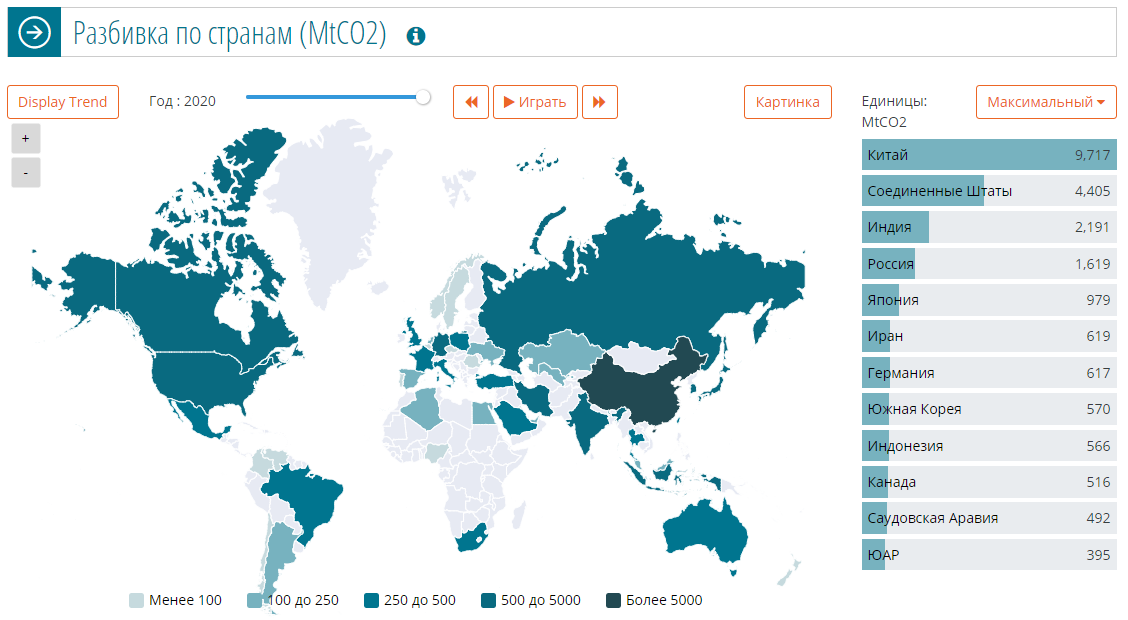
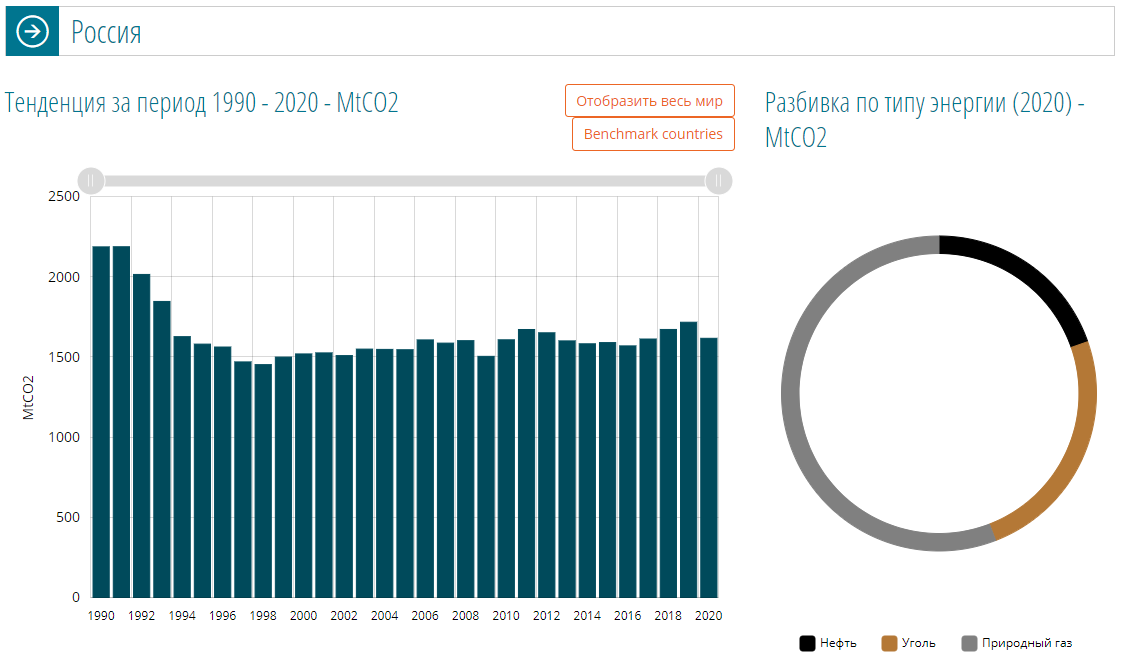
However, if we talk about the environmental aspect, I would pay attention to the second part of the slide, namely the trend in CO2 production. We see that after the collapse of the USSR and the economic upheavals of the early 1990s, CO2 production has a slight upward trend, almost completely repeating the trend in electricity generation over the same period. Therefore, this trend in CO2 production, in my opinion, is a characteristic of our attitude towards the introduction of renew-able energy technologies with a low or zero carbon footprint. Thus, practically we do not have the introduction of significant new sources of renewable energy, since the collapse of the USSR.
GROSS ELECTRICITY PRODUCTION. BREAKDOWN BY COUNTRY
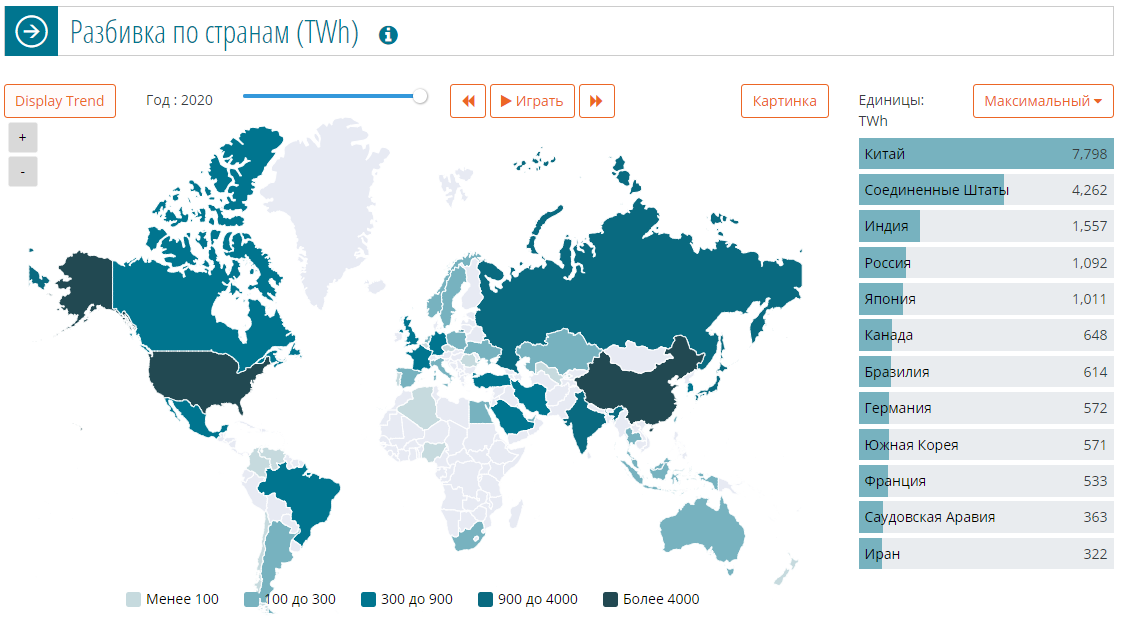
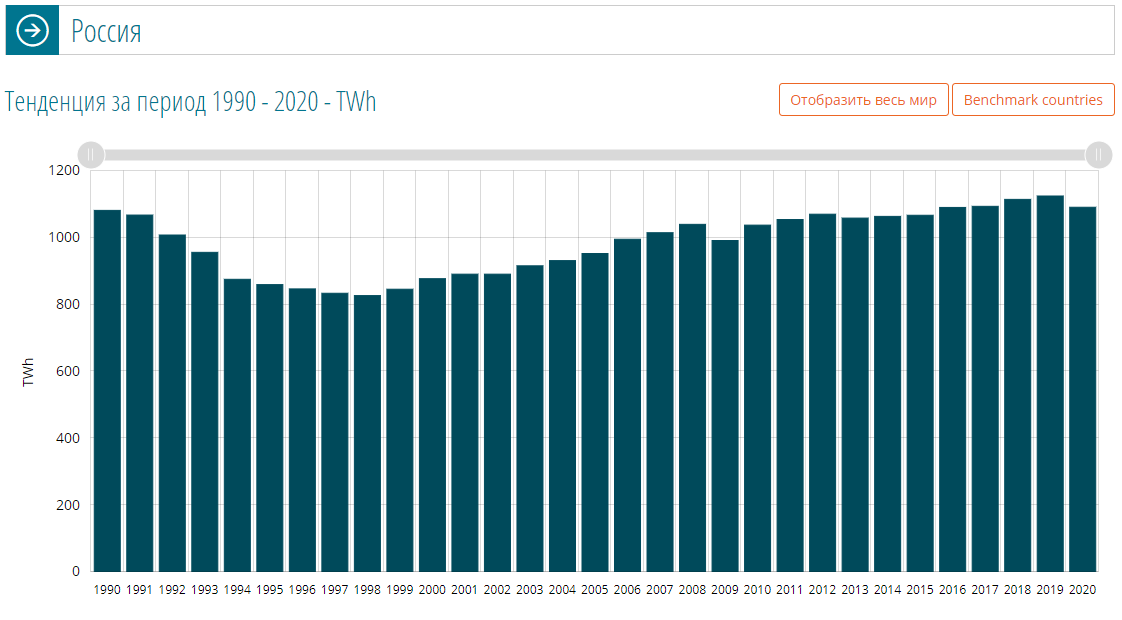
Well, maybe there are some inconsistencies in my reasoning and conclusions that the share of renewable energy sources in the total volume of electricity production is not large? … well, quite possible. However, let's turn to direct statis-tics and find out the actual share of RES in the total electricity generation (see slide below).
SHARE OF RENEWABLE ENERGY SOURCES IN ELECTRICITY PRODUCTION. LOCATION BY COUNTRY
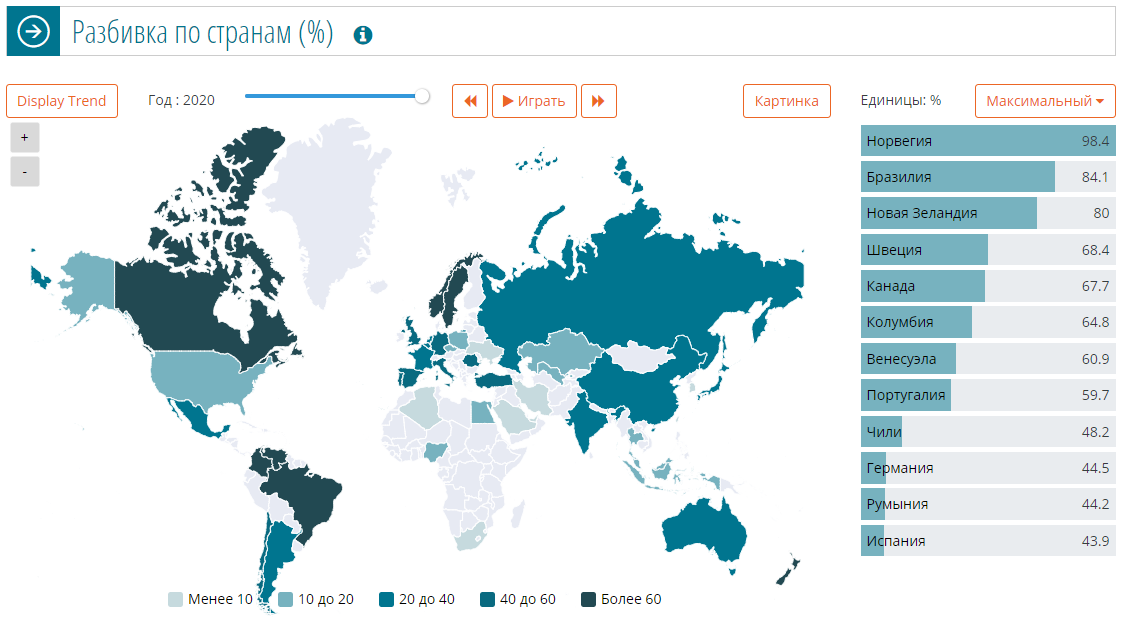
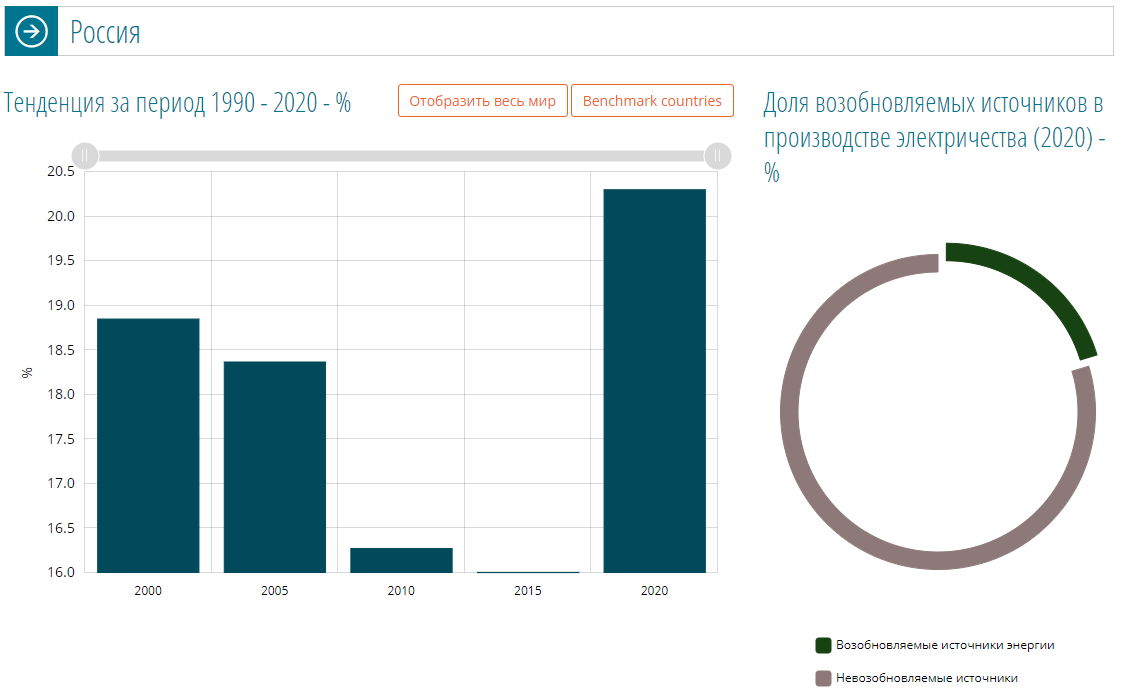
Analyzing the trend of changes in the share of renewable sources for the period 1990–2020, one can see a rather good result, within 20% for 2020. Nevertheless, deciphering the structure of renewable energy sources from these statis-tics, you understand that the bulk of renewable energy sources in Russia falls on hydroelectric power plants. Unfortunately, one of the last powerful hydroelectric power plants commissioned is the Boguchanskaya HPP (2012–2014 commissioned, capacity 3000 MW), as well as Bureyskaya HPP (2003–2007 commissioned, 2010 MW capacity). In addition, several small hydroelectric power plants with a capacity of 10 to 100 MW were put into operation, the contribution of which is not signifi-cant in relation to the total electricity generation, the operation of which did not significantly reduce greenhouse gas emis-sions. All other hydroelectric power plants were commissioned before 1990 during the Soviet era and do not in any way af-fect the shown dynamics of CO2 production. Thus, the increase in electricity generation is carried out mainly due to the tra-ditional types of fuel for us: gas, coal and oil. The share of electricity generation by wind and solar power plants in the Rus-sian Federation is a negligible amount of 0.3%.
SHARE OF WIND AND SOLAR ENERGY IN ELECTRIC POWER PRODUCTION IN THE RUSSIAN FEDERATION
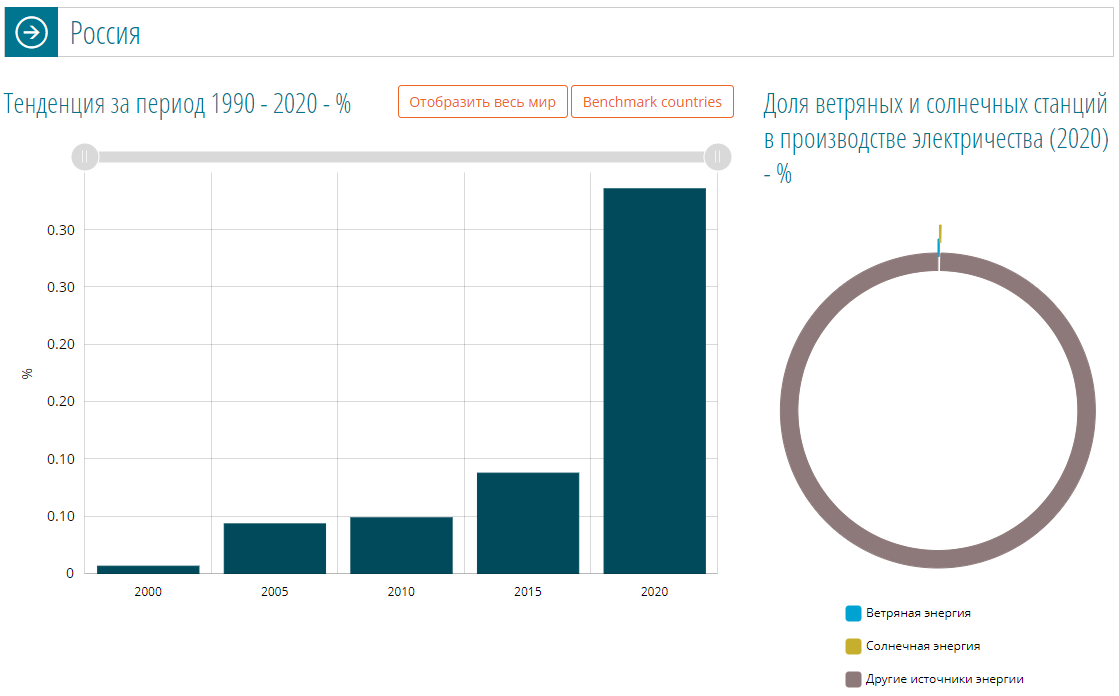
The share of hydroelectric power plants in total electricity generation exceeded 20% for the first time
Due to favorable hydrological conditions and increased water content in reservoirs, electricity production at Russian HPPs increased by 12.5% in the first nine months of this year to a record level of 160.8 billion kWh. For the first time in the modern history of Russia, the share of HPPs in total electricity generation ex-ceeded twenty%.
04/12/2020
So, answering the question: "What influence does Russia have on the emission of greenhouse gases and, according-ly, on global warming in the world?" - it is safe to say SIGNIFICANT!
If so, then what strategy should be adopted in our country to replace traditional fossil fuels? --- Is a rather difficult question. Whether to develop wind and solar energy in our country (according to the experience of European countries), where for 6-7 months there is winter or polar night. Maybe Krasnodar Territory or Stavropol Territory (territories with warm climate) – shouldn’t we confiscate fertile land from the agricultural sector for the installation of solar panels or wind genera-tors. And, the lack of an industry that produces wind turbines of high power (and small ones too), and solar panels, including, does not allow counting on the intensive introduction of these technologies in the Russian Federation. And is it worth it if we have a huge scientific and industrial base in the field of more traditional technologies for us with a zero carbon footprint of electricity production, such as the nuclear industry and hydropower. Both technologies have their pros and cons, and you can talk about them none stop. However, I would like to note that the development of nuclear power today is also due to the development of small nuclear power, autonomous power sources - the process of developing small nuclear reactors from 1 to 10 MW is underway. For example, since May 2020, the Russian floating nuclear thermal power plant "Akademik Lomono-sov" has been in operation with the delivery of up to 60 MW of electricity and up to 50 Gcal / h of thermal energy to the grid for heating water on the coastline in the Far North (Chukotka). Using this example, it is easy to imagine the time when the old coal and gas power plants will be replaced by nuclear power plants of "small" power. Of course, the widespread use of small nuclear reactors is only true if 1200% safety for people and the environment is ensured, both during the operation of such power plants and during the disposal of spent nuclear fuel.
I am not talking about the degree of “greenness” of nuclear energy (there is a serious debate about this in the EU Euro commission), but the reduction of CO2 emissions; significant fluctuations in gas prices and, accordingly, prices for 1 kW of electricity for the end user; The frequency of the capacities generated by solar energy and wind energy (peak consump-tion, day / night, natural disasters, winter / summer, etc.) makes the advantages of nuclear power obvious.
3. EUROPEAN “GREEN” GAME RULES - INTRODUCTION OF CROSS-BORDER TAX.
The European Union plans a transition to a zero-carbon economy by 2050 - and these ambitious goals require huge in-vestment costs to solve problems and develop technologies for the production, distribution, storage of electricity from re-newable sources (wind and solar energy). If today, taking into account the current “old” power system with “dirty” fossil technology, which is overwhelming in the total share of electricity generation, it is possible to solve the issues of smoothing peak electricity consumption, then how to solve them with a complete rejection of coal and gas? It is necessary to develop and implement technologies that allow solving these problems without the participation of coal and gas energy, and quite cheap / competitive technologies.
Over the past decade, by a significant margin, the largest investor in the creation of renewable energy fa-cilities has been China, which invested $ 758 billion between 2010 and the first half of 2019, the second larg-est investor was the United States, which invested $ 356 billion, and the third is Japan, which has invested $ 202 billion. Over the same period, Europe as a whole invested $ 698 billion in renewable energy capacity, of which Germany ($ 179 billion) and the United Kingdom ($ 122 billion) contributed the most.).
All of this ~ US $ 700 billion EU investment in renewable energy (mainly wind and solar) in the amount of ~ US $ 700 bil-lion has replaced a significant share of conventional fuels in total electricity production from 15% in Austria to 32% in Ger-many. Unfortunately, the payback of projects without government subsidies is at a very low level (projects are actually not payback). At the beginning of the introduction of technologies, the cost of 1 kWh produced on renewable energy sources (solar panels, wind generators) was several times higher, even tens of times higher than the cost of 1 kWh produced on tra-ditional types of fossil fuels. And of course, without compensation for expenses to generating companies, for example, through tariffs or purchases of "green" energy directly by the state, was out of question. The development of technologies and the widespread dissemination of "green" energy in the countries of the European Union, although it allowed to reduce the cost of electricity, but all subsidies have actually been paid and are currently being paid at the expense of residents of the countries of the European Union. On the slide "The share of wind and solar energy in electricity production" below, it can be seen that almost all the leaders in the introduction of renewable energy sources are European countries (with the exception of New Zealand - 4th place, and Chile - 10th place in the ranking of the most developed countries in terms of use of wind and solar energy).
SHARE OF WIND AND SOLAR ENERGY IN ELECTRIC POWER PRODUCTION
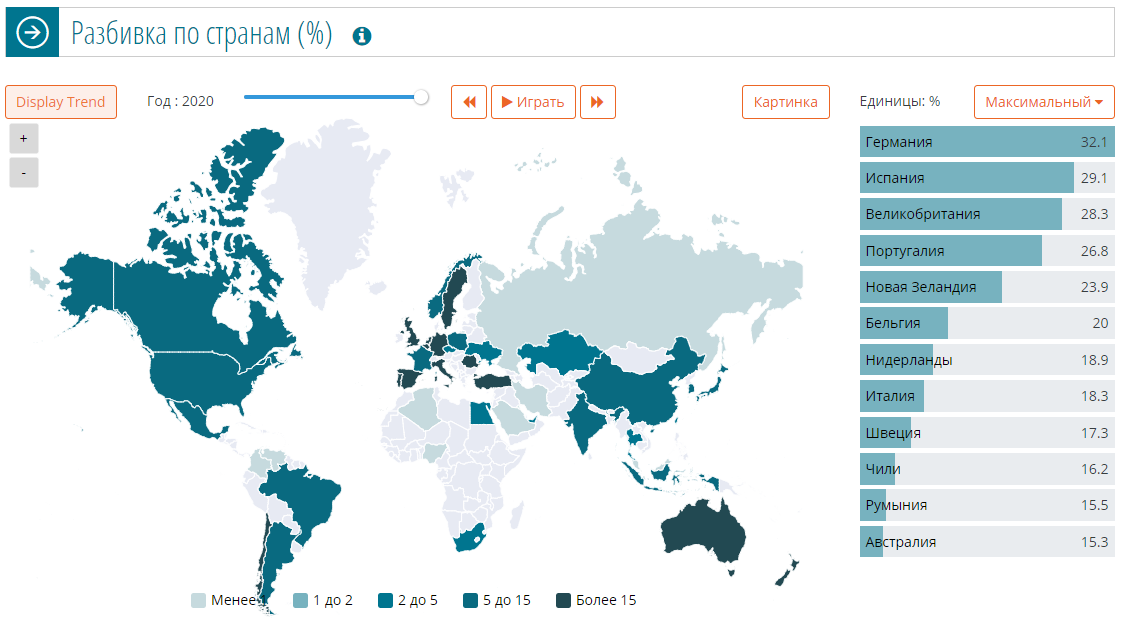
Progress comes at a cost. However, while the energy transition is paid for by European consumers, since subsidies for the development of "green" energy are included in the prices of hydrocarbons. We see how much investment has already been spent on the wider introduction of renewable energy sources (~ $ 700 billion over 10 years) and we see what part of electricity, even among the leaders of "green" energy, needs to be replaced in the near future (from 85% in Austria up to 70% in Germany), not to mention the ordinary member states of the European Union, in which the share of renewable ener-gy sources in the total balance of generation or consumption of electricity is negligible. And these planned investments are several times, tens of times higher than has already been spent on the introduction of wind and solar energy. And already to shift such a volume of costs onto the shoulders of European residents, without a significant increase in the price of electrici-ty, and, accordingly, the cost of production, and, as a consequence, a decrease in the standard of living, will not be possible. This process will be aggravated by the ambitious goal of eliminating fossil fuels, there is very little time left to implement plans for the transition to "green" energy - by 2030 the share of RES (renewable energy sources) should be 40%, and by 2050 - 100%.
In this regard, the EU government decided to shift part of its responsibility for “greening” the energy sector, or rather, part of its investments, onto residents of other countries, deciding to introduce the so-called carbon tax. In principle, posi-tion of the European Union can be understood why it should put its producers in a knowingly losing situation, increasing their costs, thereby increasing the competitiveness of products from countries with “low environmental responsibility”. Thus, the European Union gives a choice - either invest in our plans to increase the share of RES, or invest in your own.
Europe invoiced Russia for 38 billion euros
Payments of Russian companies for cross-border carbon tax on goods supplied to the European Union may amount to 37.7 billion euros by 2035. The consulting company KPMG presented this estimate. The EC proposed to introduce "climatic" customs duties on imports of iron and steel (including pipes and rails from them), aluminum, cement, fertilizers and electricity to the EU. The highest costs are typical for ferrous metallurgy companies, whose share in the total financial burden is 67-79% The possibility of expanding the list of taxable products will be considered. Pulp and paper products, oil products, petrochemical products, potash fertilizers can be added to it.
Russia will pay over a billion euros a year due to the new EU tax.
According to the newspaper, suppliers of Russian goods with a large carbon footprint, such as iron, steel, nitrogen fertilizers, electricity, aluminum and others, will in fact be forced to pay an additional ad valorem duty of 16 percent of the value of the product. In 2020, Russia supplied the EU with similar goods worth almost seven billion euros, thus the tax per year could amount to 1.1 billion euros. It is noted that Russia considers the EU carbon tax incompatible with the rules of the World Trade Organi-zation (WTO). Thus, the Minister of Economic Development Maxim Reshetnikov noted that Russia, de-spite all the assurances of its European colleagues about compliance with the letter and spirit of the WTO agreement, is not sure of this.
Of course, disputes about the compliance of this tax with the WTO standards will go on, for this there are three more years, but something suggests that business will again remain the last resort, and it will have to solve all problems on its own, especially for exporting companies. If you want to trade with Europe, you have to trade according to their rules. There re-mains only one question: should we invest in our own projects, or should we pay for the projects of the European Union? For me, the choice is obvious - investing in “greening” my own energy sector is more promising both in terms of return on investment and in terms of becoming a company with “high environmental responsibility”, a company, if not with zero, but with a low carbon footprint.
4. THE ETERNAL QUESTION "WHAT TO DO?"
In the process of discussing the carbon footprint, very little attention is paid to the production of green energy from biofuels, namely from bark and wood waste (BWW) generated during the deep processing of wood, such as: bark, wood chips, sawdust, dust from grinding and etc. Utilization of this waste for the purpose of generating electricity is a technology with zero carbon footprint. The point is not that when fuel is burned, carbon dioxide is not emitted, but that a balance is maintained between the amount of CO2 consumed by trees during their life, and the amount of CO2 emitted when burning wood fuel. That is why the technology of combustion of biomass (wood waste, agricultural waste) is a technology with a zero carbon footprint. Thus, burning wood waste does not increase the accumulation of carbon dioxide in the earth's atmos-phere, when all other things being equal
Therefore, the question of the expediency of investing in boilers operating on BWW for the pulp and paper industry should disappear. YES, you need to invest! Even due to the fact that it is planned to expand the list of taxable products and may include pulp and paper products. There are already requests from the EU to the producers of paper and cardboard in the Russian Federation to confirm the existing technology for compliance with the zero carbon footprint policy. Similar re-quests for compliance with "green" energy can be received by all timber processing enterprises, namely: the production of wood-based panels (plywood, chipboard, OSB), the production of logs, etc. This is especially true for companies focused on the European market.
Yes, it is true, “green” energy is quite expensive, but the production of electricity from bio-fuels in most cases is highly profitable, i.e. payback. And as an additional factor of payback when evaluating a project, it is necessary to take into account either the possible loss of the European market, or the payment of a cross-border carbon tax. Depending on the share of exports of products, these factors can be decisive in calculating the payback of the project. This is true for all enterprises engaged in deep processing of wood, due to the need to utilize waste in the production of finished products, but what should the enterprises of heavy industry do that do not have this waste for processing (metallurgy, cement, mineral fertiliz-ers)? In my opinion, in this case, it becomes possible to purchase "green certificates" from wood-processing enterprises, which for the latter will also be an additional factor in the payback of projects that will be able to lay down the production of electricity, when implementing new energy projects, in the maximum volume, even more. Their needs, precisely for the is-suance of this kind of "green" certificates. Moreover, according to European experience, the cost of electricity according to the certificate data can be higher than a simple supply of electricity to the grid.
You can also consider the emergence of collaborations / associations between heavy industry enterprises (metallurgy, cement industry) and timber industry, with the aim of investing in individual energy projects. For example, as we can see, the cross-border tax on metallurgists can be up to 1.1 billion euros per year. And for this amount, you can invest in the construc-tion of 40 new biofuel thermal power plants Wellons (TPP), with the possibility of a total generation of up to ~ 1000 MW of electricity. Wellons (USA) is the only company in the world that has the knowledge and skills of all biofuel combustion tech-nologies and manufactures boilers with a unit heating capacity from 5 to 300 MW. For example, one of the first projects in the Russian Federation was a project to build a boiler for the disposal of sludge in the pulp and paper industry at Solikam-skbumprom JSC, which has been operating trouble-free for more than 20 years since 2000, providing the generation of “green” electricity.
This example shows what can be done with investments from only one year of future cross-border tax payments. Why invest huge annual sums in the "green" energy of the European Union, when, with greater efficiency and benefit, you can invest in the development of your own business, while increasing your responsibility and participation in the process of re-ducing greenhouse gas emissions. Become an environmentally responsible company, descendants will thank you.
